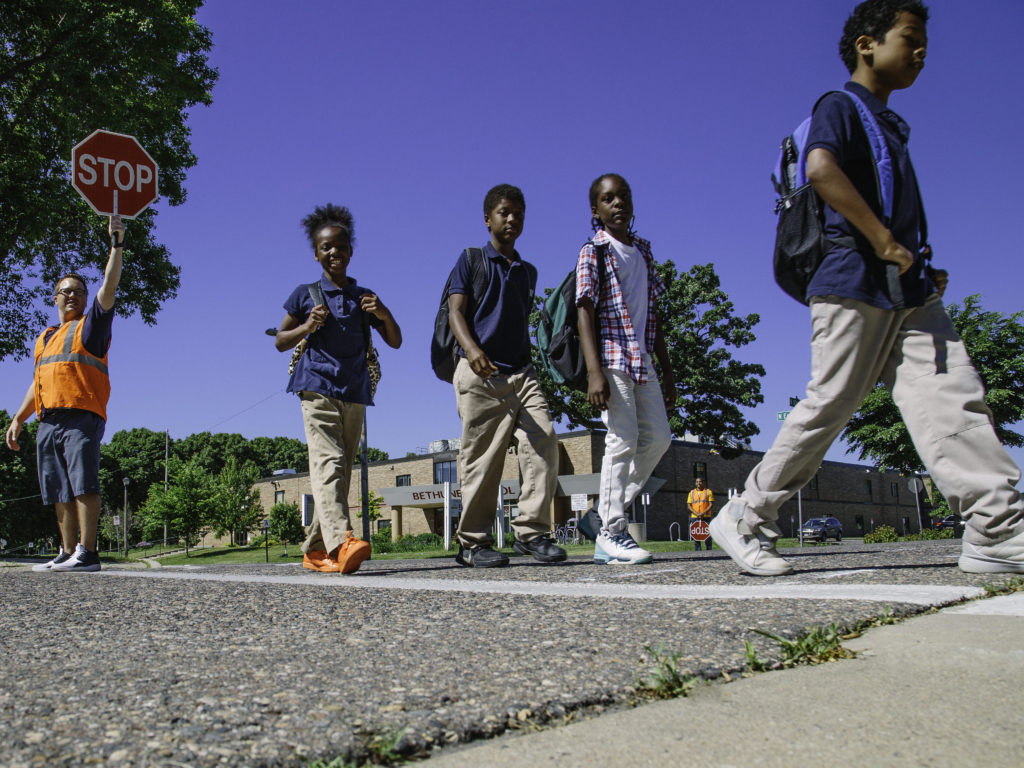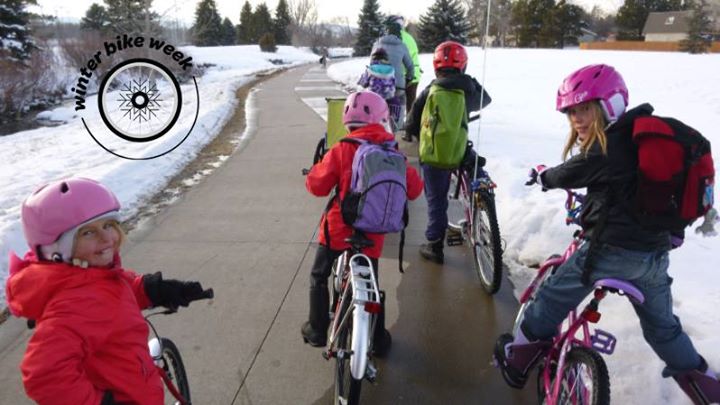Walk! Bike! Fun! & Education Standards
The Walk! Bike! Fun! curriculum addresses Minnesota Physical Education Standards and Benchmarks and is an important part of the Minnesota Department of Transportation’s Safe Routes to School Program.

Designed for Minnesotan Classrooms
The Walk! Bike! Fun! (WBF) Pedestrian and Bicycle Safety Curriculum was developed by the Bicycle Alliance of Minnesota (BikeMN) through a contract with the Minnesota Department of Transportation (MnDOT) in collaboration with BlueCross BlueShield of Minnesota. Its continued implementation and improvements continue to be funded through the Minnesota Safe Routes to School Program at MnDOT as well as through the Minnesota Department of Health.

The Minnesota Walk! Bike! Fun! Pedestrian and Bicycle Safety Curriculum…
…is a modular curriculum designed specifically for Minnesota’s schools and youth education programs. Walk! Bike! Fun! helps children of all abilities ages five to 13 learn traffic rules and regulations, the potential hazards to traveling on foot and on bike, and physical skills needed to bike and walk effectively, appropriately and safely through their community. The curriculum is written with physical education teachers in mind, but may also be taught in Social Studies, Health, and Science classes. Goals for the Minnesota Walk! Bike! Fun! Pedestrian and Bicycle Safety Curriculum are:
- Increase the number of students who safely walk and bicycle to school and in their community
- Increase safety of youth pedestrians and bicyclists
- Improve the lives of children by improving health, learning capacity, and independence
Walk Fun! Unit
The Walk Fun! unit teaches pedestrian safety and is geared for students in kindergarten through third grade.
Whether walking with adult family members or with friends, learning basic pedestrian safety may help prevent injuries and prepare children for a lifetime of safe walking. Preventing pedestrian injuries requires a combination of approaches: engineering strategies to improve the physical environment for walking, enforcement strategies to reduce vehicle speeds and increase driver yielding to pedestrians, and education strategies to increase safety skills for pedestrians.

In the Walk Fun! unit children learn how to walk safely near traffic, cross the street at a crosswalk and safely cross the street around visual barriers, and how to safely cross the street at an intersection using crossing signals and traffic signs.
The last session takes the children on a fun and leisure walk through the neighborhood around the school to practice understanding of pedestrian safety. The Walk Fun! unit consists of four thirty-minute lessons for kindergarten through third grade students. Of the four lessons, there are activities for every style of learner with concepts being taught through vocabulary, videos, music, exercises, signs, numbers, shapes, and culminating with a walk around the neighborhood. Each lesson addresses a variety of Minnesota Physical Education Standards and Benchmarks which are outlined in each lesson.

Bike Fun! Unit
The Bike Fun! teaches bicycle safety curriculum and is geared for fourth through eighth grade.
It consists of many activities where children on bicycles learning and practicing safe bicycle handling skills as well as traffic laws that make their biking experience more rewarding and enjoyable. Throughout the unit, students will be learning rules of the road, a quick safety check for their bicycles, how to properly fit a helmet, how to optimally pedal and brake, where to ride on the road, how to communicate with other traffic, and finally, ride bicycles through the community!
The Bike Fun! unit consists of eight thirty-minute lessons with four bonus lessons to include topics in health and physical education.
The eight bicycle safety lessons are for fourth through eighth grade classes and addresses a variety of Minnesota Physical Education Standards and Benchmarks while the bonus lessons address a variety of National Health Education Standards. Within the bicycle safety unit there are lessons that use pictures, signs, flashcards, guest speakers, videos, bicycle helmets, and bicycles! The last two days of the unit students will be riding bicycles on a designated routes with educators and volunteers!
The “best practice” approach to teaching the Bike Fun! unit is team teaching with a Health, Social Studies, or Science teacher. The team teacher has four Bonus Lessons in the curriculum that are designed for the classroom to teach students about bicycling courtesy and communication, making healthy choices and having good sleeping habits, understanding peripheral vision and reaction time. In these lessons there are National Health Standards that are outlined and addressed in each lesson.
What is your favorite part of teaching the curriculum?
“I love teaching it because it’s different, a lifetime activity. ”
Richfield Physical Education Teacher
Stacie, a physical education teacher at Fond du Lac Ojibwe School said
“Walk! Bike! Fun! is one of the best curricula I have ever used with the kids, I will definitely use it again and again.”
Minnesota Physical Education Standards
Standard 1
The physically literate individual demonstrates competency in a variety of motor skills and movement patterns.
Standard 2
The physically literate individual applies knowledge of concepts, principles, strategies, and tactics related to movement and performance.
Standard 3
The physically literate individual demonstrates the knowledge and skills to achieve and maintain a health-enhancing level of physical activity and fitness.
Standard 4
The physically literate individual exhibits responsible personal and social behavior that respects self and others.
Standard 5
The physically literate individual recognizes the value of physical activity for health, enjoyment, challenge, self-expression, and/or social interaction.
National Health Standards
Standard 1
Students will comprehend concepts related to health promotion and disease prevention to enhance health.
Standard 2
Students will analyze the influence of family, peers, culture, media, technology, and other factors on health behaviors.
Standard 3
Students will demonstrate the ability to access valid information, products, and services to enhance health.
Standard 4
Students will demonstrate the ability to use interpersonal communication skills to enhance health and avoid or reduce health risks.
Standard 5
Students will demonstrate the ability to use decision-making skills to enhance health.
Standard 6
Students will demonstrate the ability to use goal-setting skills to enhance health.
Standard 7
Students will demonstrate the ability to practice health-enhancing behaviors and avoid or reduce health risks.
Standard 8
Students will demonstrate the ability to advocate for personal, family, and community health.
